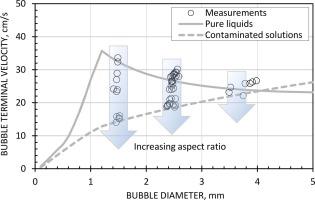当前位置:
X-MOL 学术
›
Miner. Eng.
›
论文详情
Our official English website, www.x-mol.net, welcomes your
feedback! (Note: you will need to create a separate account there.)
Bubble shape in the prediction of terminal velocities in flotation
Minerals Engineering ( IF 4.9 ) Pub Date : 2024-05-10 , DOI: 10.1016/j.mineng.2024.108709 Cesar O. Gomez , Miguel Maldonado
Minerals Engineering ( IF 4.9 ) Pub Date : 2024-05-10 , DOI: 10.1016/j.mineng.2024.108709 Cesar O. Gomez , Miguel Maldonado

|
Minerals flotation is a process that involves the formation of a population of bubbles to produce a concentrate by selective capture and separation of particles of valuable hydrophobic minerals on the surface of bubbles. The bubble rising velocity is a crucial piece of information for developing operating and control strategies, and for estimating metallurgical performance of flotation circuits. Bubble rising velocities depend on their size and on the physicochemical characteristics of the surrounding liquid medium. Velocities in pure liquids are the largest possible because gas-liquid interfaces remain clean and fully mobile allowing circulation of the gas phase, but when surfactants and ions from soluble mineral species are present (contaminated liquid), which is the case in minerals flotation, a molecular arrangement of adsorbed molecules develops on the surface of the bubbles. This structure reduces bubble surface mobility as internal gas circulation is restricted, velocity is reduced, and shape evolves from oblate spheroidal to spherical. Models proposed to predict the terminal velocity of bubbles have been devised, in general, for working at two extreme sets of conditions: bubbles rising either with fully mobile surfaces in pure liquids, or with rigid surfaces in highly contaminated liquids. The purpose of this work was the assessment of bubble velocity predictions of models that have been used in flotation applications; a data set of simultaneous measurement of velocity and shape of rising single bubbles under a broad set of conditions relevant for minerals flotation was used. The results demonstrated that bubble velocity and aspect ratio were intrinsically linked, and for bubbles of the same size, consistent trends between terminal velocity and aspect ratio that included measurements in frother and polymer solutions. Measurements in solutions of four frothers showed, as expected, significantly different terminal-velocity reduction trends as the frother concentrations were increased. This was considered as a demonstration that the frother molecular structure and the extent of equilibrium coverage were frother dependent. Model assessment demonstrated that prediction of terminal velocities was not possible for contaminated solutions with frother concentrations below the levels that get bubble surfaces fully covered. The measurements collected in this work were used to develop an empirical model for predicting bubble velocities as a function of aspect ratio; the comparison of measured and predicted velocities had a correlation coefficient of 0.9987.
中文翻译:

浮选终端速度预测中的气泡形状
矿物浮选是一个涉及形成大量气泡的过程,通过选择性捕获和分离气泡表面上有价值的疏水性矿物颗粒来生产精矿。气泡上升速度是制定操作和控制策略以及评估浮选回路冶金性能的重要信息。气泡上升速度取决于其大小和周围液体介质的物理化学特性。纯液体中的速度可能是最大的,因为气液界面保持清洁且完全可移动,允许气相循环,但是当存在表面活性剂和来自可溶矿物种类的离子(污染液体)时,就像矿物浮选中的情况一样,吸附分子的分子排列在气泡表面形成。这种结构降低了气泡表面的流动性,因为内部气体循环受到限制,速度降低,并且形状从扁球状演变为球形。一般来说,预测气泡最终速度的模型是为了在两种极端条件下工作而设计的:气泡要么在纯液体中完全移动的表面上升,要么在高度污染的液体中以刚性表面上升。这项工作的目的是评估浮选应用中使用的模型的气泡速度预测;使用了在与矿物浮选相关的广泛条件下同时测量单个气泡上升的速度和形状的数据集。 结果表明,气泡速度和长径比具有内在联系,并且对于相同尺寸的气泡,终端速度和长径比之间存在一致的趋势,包括在起泡剂和聚合物溶液中的测量。正如预期的那样,对四种起泡剂溶液的测量表明,随着起泡剂浓度的增加,终端速度降低趋势显着不同。这被认为是起泡剂分子结构和平衡覆盖程度取决于起泡剂的证明。模型评估表明,对于起泡剂浓度低于气泡表面完全覆盖水平的污染溶液,不可能预测终端速度。这项工作中收集的测量结果用于开发一个经验模型,用于预测气泡速度与纵横比的函数关系;测量速度和预测速度的比较相关系数为0.9987。
更新日期:2024-05-10
中文翻译:

浮选终端速度预测中的气泡形状
矿物浮选是一个涉及形成大量气泡的过程,通过选择性捕获和分离气泡表面上有价值的疏水性矿物颗粒来生产精矿。气泡上升速度是制定操作和控制策略以及评估浮选回路冶金性能的重要信息。气泡上升速度取决于其大小和周围液体介质的物理化学特性。纯液体中的速度可能是最大的,因为气液界面保持清洁且完全可移动,允许气相循环,但是当存在表面活性剂和来自可溶矿物种类的离子(污染液体)时,就像矿物浮选中的情况一样,吸附分子的分子排列在气泡表面形成。这种结构降低了气泡表面的流动性,因为内部气体循环受到限制,速度降低,并且形状从扁球状演变为球形。一般来说,预测气泡最终速度的模型是为了在两种极端条件下工作而设计的:气泡要么在纯液体中完全移动的表面上升,要么在高度污染的液体中以刚性表面上升。这项工作的目的是评估浮选应用中使用的模型的气泡速度预测;使用了在与矿物浮选相关的广泛条件下同时测量单个气泡上升的速度和形状的数据集。 结果表明,气泡速度和长径比具有内在联系,并且对于相同尺寸的气泡,终端速度和长径比之间存在一致的趋势,包括在起泡剂和聚合物溶液中的测量。正如预期的那样,对四种起泡剂溶液的测量表明,随着起泡剂浓度的增加,终端速度降低趋势显着不同。这被认为是起泡剂分子结构和平衡覆盖程度取决于起泡剂的证明。模型评估表明,对于起泡剂浓度低于气泡表面完全覆盖水平的污染溶液,不可能预测终端速度。这项工作中收集的测量结果用于开发一个经验模型,用于预测气泡速度与纵横比的函数关系;测量速度和预测速度的比较相关系数为0.9987。











































 京公网安备 11010802027423号
京公网安备 11010802027423号